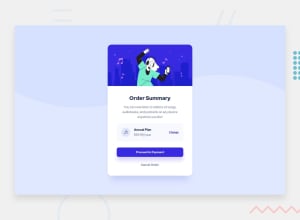
Design comparison
Solution retrospective
It was great for the very first time to use: -Flexboxes -Shadows -Psuedo selectors -Focus more on measuring units -Even give @media a try
What challenges did you encounter, and how did you overcome them?The biggest challenge for me was the fact, that after I reduce the size of the page into mobile phone territory, that the "Change" link would leave the flex container. I countered that with @media making it so, that the padding for the flex item increased, if the width of the page fell below 510px. I don't know if this is the best way go go about it, so i would love some feedback.
What specific areas of your project would you like help with?I would like some guidance on how I could have handled the flex containers and flex items in them better, as the page gets resized to mobile phone dimensions.
Community feedback
Please log in to post a comment
Log in with GitHubJoin our Discord community
Join thousands of Frontend Mentor community members taking the challenges, sharing resources, helping each other, and chatting about all things front-end!
Join our Discord
